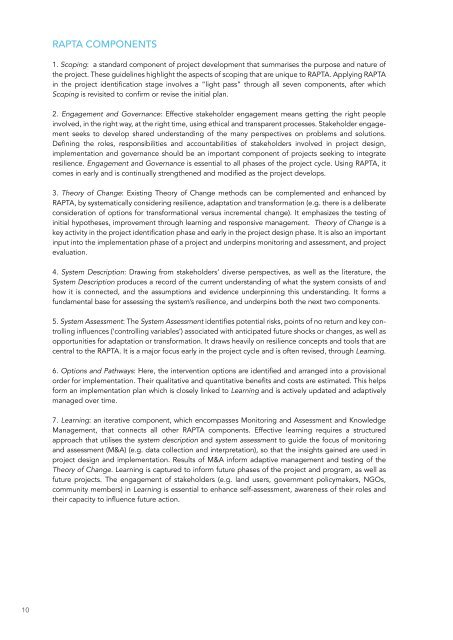DESIGNING PROJECTS IN A RAPIDLY CHANGING WORLD
srun3013fp1
srun3013fp1
Create successful ePaper yourself
Turn your PDF publications into a flip-book with our unique Google optimized e-Paper software.
RAPTA COMPONENTS<br />
1. Scoping: a standard component of project development that summarises the purpose and nature of<br />
the project. These guidelines highlight the aspects of scoping that are unique to RAPTA. Applying RAPTA<br />
in the project identification stage involves a “light pass” through all seven components, after which<br />
Scoping is revisited to confirm or revise the initial plan.<br />
2. Engagement and Governance: Effective stakeholder engagement means getting the right people<br />
involved, in the right way, at the right time, using ethical and transparent processes. Stakeholder engagement<br />
seeks to develop shared understanding of the many perspectives on problems and solutions.<br />
Defining the roles, responsibilities and accountabilities of stakeholders involved in project design,<br />
implementation and governance should be an important component of projects seeking to integrate<br />
resilience. Engagement and Governance is essential to all phases of the project cycle. Using RAPTA, it<br />
comes in early and is continually strengthened and modified as the project develops.<br />
3. Theory of Change: Existing Theory of Change methods can be complemented and enhanced by<br />
RAPTA, by systematically considering resilience, adaptation and transformation (e.g. there is a deliberate<br />
consideration of options for transformational versus incremental change). It emphasizes the testing of<br />
initial hypotheses, improvement through learning and responsive management. Theory of Change is a<br />
key activity in the project identification phase and early in the project design phase. It is also an important<br />
input into the implementation phase of a project and underpins monitoring and assessment, and project<br />
evaluation.<br />
4. System Description: Drawing from stakeholders’ diverse perspectives, as well as the literature, the<br />
System Description produces a record of the current understanding of what the system consists of and<br />
how it is connected, and the assumptions and evidence underpinning this understanding. It forms a<br />
fundamental base for assessing the system’s resilience, and underpins both the next two components.<br />
5. System Assessment: The System Assessment identifies potential risks, points of no return and key controlling<br />
influences (‘controlling variables’) associated with anticipated future shocks or changes, as well as<br />
opportunities for adaptation or transformation. It draws heavily on resilience concepts and tools that are<br />
central to the RAPTA. It is a major focus early in the project cycle and is often revised, through Learning.<br />
6. Options and Pathways: Here, the intervention options are identified and arranged into a provisional<br />
order for implementation. Their qualitative and quantitative benefits and costs are estimated. This helps<br />
form an implementation plan which is closely linked to Learning and is actively updated and adaptively<br />
managed over time.<br />
7. Learning: an iterative component, which encompasses Monitoring and Assessment and Knowledge<br />
Management, that connects all other RAPTA components. Effective learning requires a structured<br />
approach that utilises the system description and system assessment to guide the focus of monitoring<br />
and assessment (M&A) (e.g. data collection and interpretation), so that the insights gained are used in<br />
project design and implementation. Results of M&A inform adaptive management and testing of the<br />
Theory of Change. Learning is captured to inform future phases of the project and program, as well as<br />
future projects. The engagement of stakeholders (e.g. land users, government policymakers, NGOs,<br />
community members) in Learning is essential to enhance self-assessment, awareness of their roles and<br />
their capacity to influence future action.<br />
10


